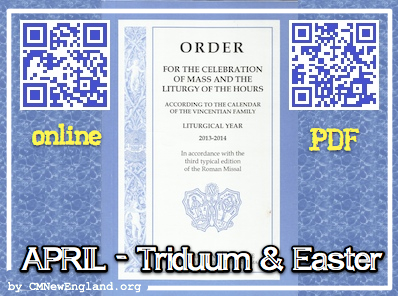 Liturgical norms for Good Friday celebrations according to ORDO – Liturgical calendar for the Vincentian Family.
Liturgical norms for Good Friday celebrations according to ORDO – Liturgical calendar for the Vincentian Family.
LITURGY OF THE DAY
The Liturgy of the Hours is celebrated with the special features indicated in the Proper of Time.
It is highly appropriate that the Office of Readings and Lauds be celebrated in solemn fashion with the people (IH, 210).
THE CELEBRATION OF THE PASSION OF THE LORD, as in the Missal.
Liturgical color: Red
Rl Is 52, 13-53, 12;
Ps 30, 2 and 6.12-13.15-16. 17 and 25.
R2 Hebr4, 14-16; 5, 7-9.
Go In 18, 1-19, 42.
l. On this day, when Christ our paschal Lamb was sacrificed, the Church contemplates and adores the Cross of her Lord and Spouse, commemorating her own coming forth from the side of Christ as he slept on the Cross, and interceding for the salvation of all the world.
2. According to a most ancient tradition, the Church does not celebrate the Eucharist on this day.
Holy Communion is distributed to the faithful only within the celebration of the Lord’s Passion, but it may be brought at any hour of the day to the sick who cannot participate in this celebration.
3. There should be no celebration of the Sacraments today, except for the Sacraments of Penance and of Anointing of the Sick. Funerals should be conducted without singing and without organ music or the ringing of bells.
4. The Celebration of the Lord’s Passion is to take place in the afternoon, round about 3 p.m. If, however, genuine pastoral reasons require it, the celebration may take place at a more suitable time, but not before noon and not after 9 p.m.
5. The whole liturgy should be conducted according to the prescriptions of the liturgical books. No changes should be introduced on private initiative.
6. The altar should be completely bare: without cloths, cross or candlesticks.
7. For the reading of the Lord’s Passion on Good Friday, see the notes given above for Palm Sunday (cf. p. 91, n. 7).
8. The cross which is shown to the people and proffered for adoration should be sizeable and of a certain beauty. The formula for the showing of the cross and the people’s response should be sung. For reasons of appropriate symbolism, there should be a single cross for adoration but care should be taken that the individual faithful are able to adore the cross, a feature of great importance in today’s celebration. The rite by which the cross is adored in silence by the whole congregation as a body should be used only if the faithful are present in very large numbers.
9. After the celebration of the Lord’s Passion, the Blessed Sacrament should be carried back in a simple way to the place of reservation and kept there with the usual lamp bunting. The altar should be stripped in private, but leaving the cross and Candlesticks. It is fitting that a place be arranged (as, for example, the chapel used for reposition and adoration of the Blessed Sacrament the previous evening), suitable for prayer and meditation, and that the cross be placed there to be adored by the faithful.
10. Of great significance are also the popular devotional exercises that are of pastoral importance, such as the Stations of the Cross, processions of the Lord’s Passion, the commemoration of the Sorrows of Our Lady. Their texts and sung parts should be in harmony with the liturgy, and should lead the people to true liturgical participation.
VESPERS are not recited by those who take part in the celebration of the Lord’s Passion.
COMPLINE as after Second Vespers of Sunday.
For more information visit this page:
ORDO – Liturgical Calendar of the Vincentian Family
or scan one of the codes in the image

Leave a Reply